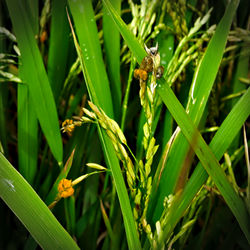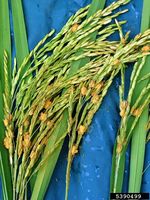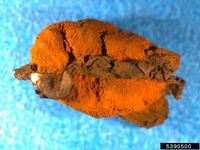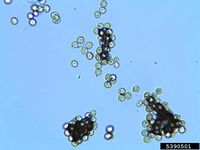Ustilaginoidea virens
| Literature database |
|---|
| 76 articles sorted by: |
| • year (recent ones first) |
| • research topics |
| • countries/regions |
| • host plants |
Ustilaginoidea virens (Cooke 1878) Takah. 1896
This fungus causes false smut of rice in various rice-producing regions. It infects the rice flowers, initially the stamen filaments before invading the rest of the spikelet. Eventually, the rice grains are transformed into velvety smut balls. The spore ball is initially covered by a white membrane which bursts, revealing the orange chlamydospores. The spores later turn yellowish-green to dark greenish. Sclerotia are often formed on the smut balls in autumn. Chlamydospores and sclerotia can persist in the soil for several growing seasons and can serve as primary infection sources.
Epidemics develop when high rainfall coincides with the rice booting stage. In infected plants, kernel production is reduced and yield losses of 25% and more have been reported. More importantly, the fungus produces the ustiloxins, antimitotic cyclic peptides. These mycotoxins contaminate the remaining grains.
| Vernacular names | |
|---|---|
| • Deutsch: | falscher Reisbrand |
| • English: | false smut of rice |
| • Français: | faux charbon du riz |
Preventive fungicide applications are used to control the disease. The fungicides are applied at the booting stage of the plant before any symptoms become visible. Several cultural methods are also recommended like crop rotation and reducing nitrogen fertilizer levels. In addition, some rice lines are less susceptible to the disease. However, the use of resistant rice cultivars is still rather limited.
The conidia are round to elliptical and warty on the surface, 3-5 µm large. Chlamydospores are spherical (3-6 µm) yellow, olivaceous or black, ornamented with prominent irregularly curved spines, which are 200–500 nm long. The sclerotia are black, irregular oblong or flat and sometimes horseshoe-shaped. They can reach a size of up to 20 mm. When the sclerotia germinate they form apothecia which produce sexual ascospores. The ascospores are filiform and septate, 140-230 µm long. They each separate into 4 one-celled sections, 30-60 µm long. The fungus appears to be homothallic (Fu et al., 2014).
Synonyms:
Claviceps oryzae-sativae
Claviceps virens
Villosiclava virens
For a review see Fan et al., 2016
- Other images of Ustilaginoidea virens (IPM Images - click to enlarge)



